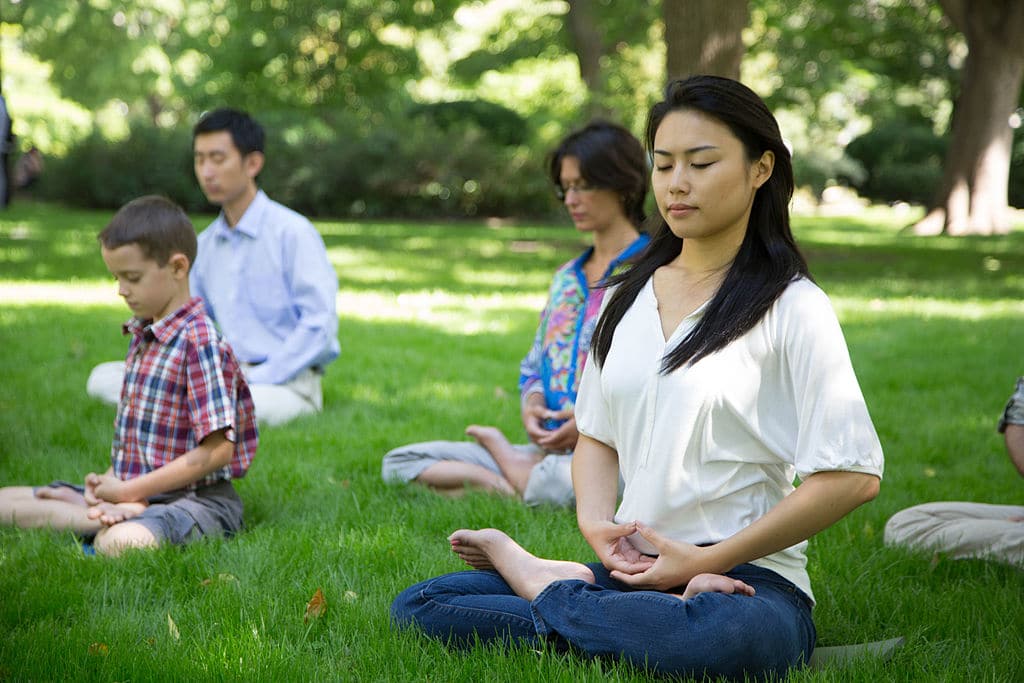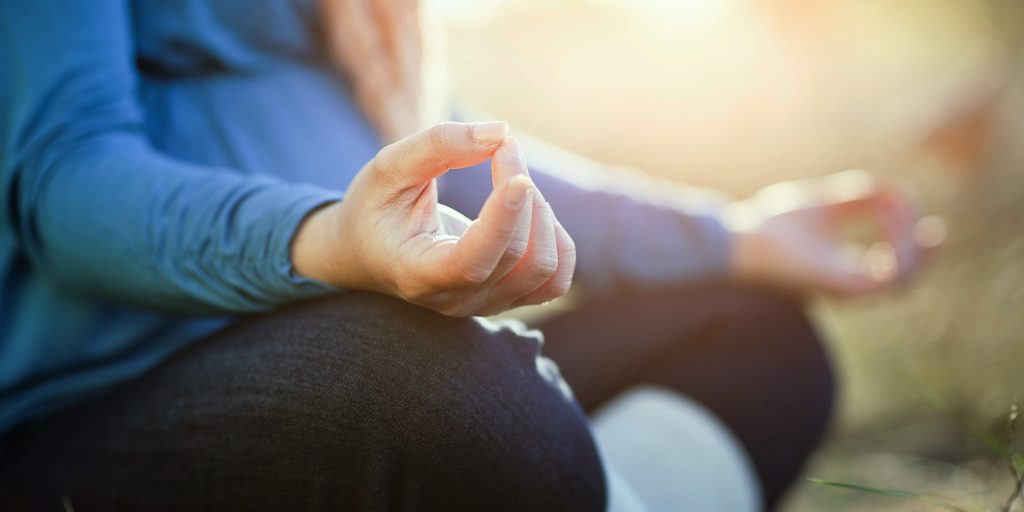In this article, I will guide everyone to practice Vipassana meditation. Currently, in Vietnam there are also a number of Vipassana meditation courses, however these courses are usually long days and during the meditation courses you will be limited from using phone devices.
Of course, if you can arrange to attend these courses, it will be great because there will be meditation teachers to guide you and a community to practice meditation with. But I think not everyone can arrange the time to participate.
I guarantee you can practice right after reading this article.
I would like to note that I am not a Zen master or practitioner, I am just a normal person who comes to meditation to relieve stress in life, work more focused, have a more peaceful mind,... Here is my experience and what I know after learning and practicing about meditation.
What is Vipassana meditation?
Vipassana – meaning seeing things as they really are – is one of the oldest meditation methods in India. This non-sectarian method aims at eliminating mental impurities and leading to the highest happiness of complete liberation.
Vipassana is the path of self-change through self-observation. This meditation method focuses on the close relationship between mind and body. This relationship can be experienced directly by paying careful attention to the actual sensations in the body, which are always interwoven and create patterns for the mind. This journey of observation and self-discovery goes to the common root of mind and body, thereby eliminating mental impurities, bringing about a balanced mind filled with love and compassion.
The scientific laws that govern human thoughts, emotions, judgments, and sensations become clear and easy to understand. Through direct experiences, we understand how our own progress or regression occurs, how we create suffering or liberate ourselves from suffering. Our lives increase in understanding, are free from illusions, and are filled with self-control and peace. ( according to vn.dhamma.org)
There are many methods, but I follow the Vipassana meditation method because it is simple and directs people to live in reality, seeing things as they are. That is, usually when things happen, we ourselves label them as right or wrong, making inferences from those events that make our minds uneasy.
For example, when I was scolded by a commenter for not writing well but I also liked to write. Usually my reaction would be: “This guy is crazy. Obviously, I write on my blog, I don't force anyone to read it, and I don't charge a fee, but after reading it, I still curse at me" or "So boring, the article I'm so passionate about is being cursed at. I'm poor and have no real ability..."
When practicing Vipassana meditation, you will realize that it is just because we impose our own thoughts on that event. Actually, the simple thing is that they just commented and cursed at me, there is no right or wrong. That doesn't mean I'm bad, right? It simply just happened. If I like it, I will try to read and write more to improve my ability because I think it's better for me. hehe
I think the media and many articles have talked about this about the benefits of Meditation. Now I'll start right away and practice to save you time!
With Vipassana Meditation, they can meditate anytime, anywhere in many positions such as when eating, brushing teeth, walking, and of course going to the toilet :)). However, when starting out, people should sit in a basic posture for greater effectiveness, and also let themselves gradually get used to meditation first.
About sitting space.
You can choose quiet places with open space and good air circulation to sit, which will be very good. But I think we can sit anywhere, the most important thing is to practice a lot and regularly, not to find a perfect place and then sit - I also often have this disease and am " cure" gradually.
You can sit on the bed, on the floor,...or anywhere. I think you should just not sit on a mattress that is too soft because it is difficult to sit straight, but a hard mattress is still ok!
About sitting posture
When meditating, you will sit cross-legged, which can be cross-legged, or half-lotus or cross-legged position.
- Cross-legged is the position of sitting cross-legged like you would normally eat while sitting on a mat. This position is often for people who are new to meditation or have leg problems so they cannot sit in the half-lotus or half-lotus position.
- Half-lotus is a way of sitting with one leg resting on the other calf. Specifically, put the left foot on the right thigh, the right foot under the left thigh. Or put your right foot on the left thigh, the left foot under the right thigh. Depending on your body, you will feel a little difference when switching between legs in this position.
- The lotus position (also known as the lotus position) is the correct and most suitable position for meditation.
To sit cross-legged properly, first sit cross-legged naturally, use both hands to hold the right foot, slowly fold the leg and place the foot on the left thigh, heels pressed close to the abdomen, soles facing up to the sky. .
Next, use both hands to hold the left foot, fold it, place the left foot on the right thigh, gently pull the heel close to the abdomen, the foot facing the sky.
I usually sit in the half-legged position because this position makes me feel comfortable and keeps my back straight. Sitting in the lotus position now makes my limbs stiff so it's very painful and uncomfortable.
You can choose any sitting position that you find suitable.
When meditating, you should keep your back straight, slightly open your shoulders and puff your chest. You turn your face up a little and feel like you have a bunch of hair hanging from the top of your head. Your mouth is slightly open without clenching your teeth and the corners of your mouth are slightly smiling.
If you find yourself slumping a bit, lift yourself up again
These small details are quite important to help you feel more optimistic and excited when meditating. The power of language…hehe
When sitting, if you find it difficult to sit up straight, you can put a pillow under your butt to help relieve back strain (note that the pillow is only on your buttocks, but your knees are on the floor, how do you keep your knees on the floor? below the sacrum). Or buy a night dedicated to meditation called Bo Doan or something else that I don't remember. I usually use the square pillow on the sofa to sit on instead of buying a cushion.
The mind turns to the breath
Every time you sit down to meditate, the first thing you do is settle down. Settling means that you will go into the place where you intend to meditate and, completely naturally, you will review yourself. Maybe your day was a peaceful and quiet day, but maybe that day you were really tired, worried, frustrated.
First, see what your current situation is. Ask yourself these questions: What am I feeling in my body? What is my mood? What is the nature of the mind at this time?
In the most basic meditation instructions, you will meditate on your breathing - which means focusing on your breathing to meditate.
The reason the breath is used as an object of meditation is because it is temporary, always changing. Every time your mind wanders, bring it back to your breathing.
You can try focusing your attention on your exhalation and the space at the end of your exhalation before you inhale again.
You can use the app “Prana breathing“, this meditation app can help you meditate better thanks to your inhalation and exhalation following the rhythm of the sound. (You can download this mobile Meditation app)
This app has different meditation options. For example, you choose concentrated meditation.
The application's default time is about 6-7 minutes. You can increase the time to 15 minutes or practice twice as the default is enough time.
In this form of concentrated meditation, inhalation is very fast and exhalation will be slow. If you lack concentration on exhaling as usual, you will run out of breath and not be able to complete the exhalation right away. Therefore, you must concentrate to control your breathing.
I find this app very interesting and great for Meditation!
How long to practice Meditation?
How long you meditate depends on the level of success you want. It could be 15', 20' or it could be an hour. However, in the beginning, I encourage everyone to meditate for only about 15 minutes. Because we are new to meditation, it is difficult for us to sit for a long time. Then you can gradually increase the time to 20', 30' as you practice more proficiently.
The important thing in meditating is that you try to sit consistently throughout the day to feel the changes and benefits of meditation on your body, and gain new enlightenment. On my blog, I have a 30-day meditation challenge, please join the challenge to overcome yourself: Day 1 of the 30-day Meditation challenge: The journey of a thousand miles begins with the first step



Bạn ơi mình hỏi khi thiền thì nên thở bao nhiêu nhịp nên thở bình thường hay thở 1 hơi dài xuống đan điền
Thank you
thở bình thường tự nhiên nhất là đc
Bn ơi mình hỏi khi thiền thì nên thở bao nhiêu nhịp nên thở bình thường hay thở 1 hơi dài xuống đan điền
cảm ơn bạn!
Mình muốn học thiền nhưng chưa biết cách bạn hd mình nhé.Xin cảm ơn bạn.
Thank you for sharing. The article is very useful and easy to understand. Wish you have more and more good and valuable articles.